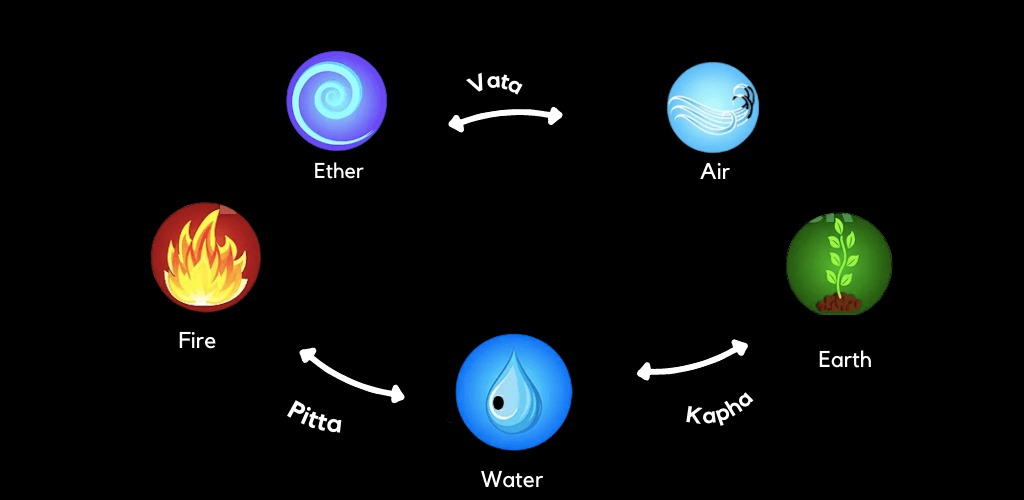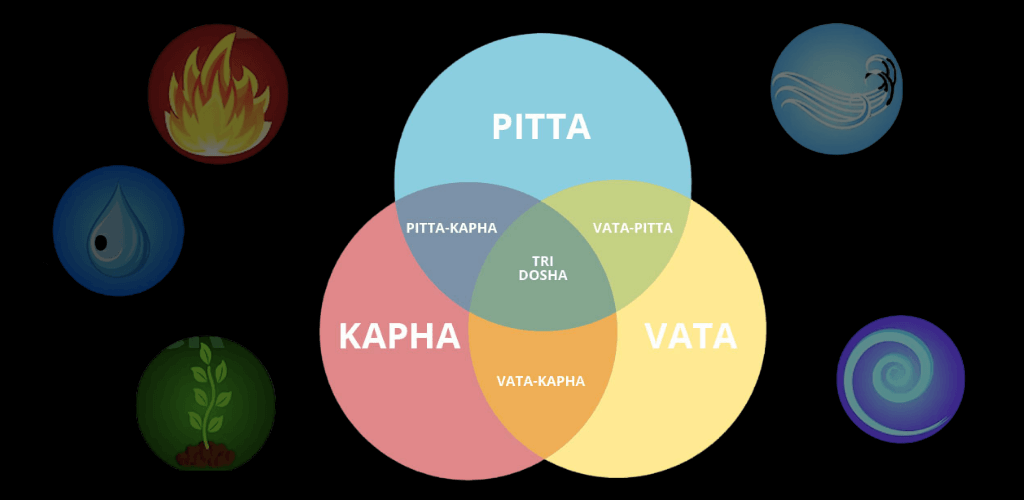
TRIDOSHA: THE SCIENCE OF AYURVEDA AND THE THREE DOSHAS.
Vata, Pitta and Kapha. These are perhaps the most popular words of Ayurveda despite their popularity very few people actually know what these words mean. In this blog, we are going to take a look at the real meaning of Vata, Pitta and Kapha.
If you have some interest in Ayurveda you would definitely have heard of the term Vata, Pitta and Kapha. we need to understand is Prapancha even though the popular meaning of the Prapancha is “World”.
It’s origins are actually like this Pancha is five. The Prapancha is that which is made up of five elements everything that is manifest in this universe is made up of these five elements called Pancha Mahabhutas, these are the elements of earth, water, fire, wind, and space.
It is the qualities of the elements that exist in everything that is manifested. The Sanskrit word for these elements are:

bhUmiH, aapaH, AgniH, vAyuH, AkAshaH.
bhUmiH, or Earth represents the properties of mass and inertia.
aapaH or water in denotes fluidity
agniH of fire represents heat and warmth
vAyuH or wind represents instability and movement
and
AkAshaH or space to present the property of occupying space.
Anything obvious is said to have these elements and their properties in different proportions. The human body is also made up of these elements, which constantly interact with each other, to carry out various bodily functions.
The concept of Vata, Pitta and Kapha.

When the air element in the body or vAyuh iinteract with the AkAshaH or space, the resultant property vata are mentioned in 10th sloka of the first chapter of ashtanga Hridayam as follows
tatra rUkshO laghuH shitaH
kharaH sUkmaH chalaH anilaH
Meaning of sloka:: The properties of Vata are as follows it is dry, light, cold, rough subtle, and mobile.

When the water element in the body interact with the fire element which is bodily heat the properties of both these elements interact to form pitta. the resultant properties of pitta are mentioned in the 11th Shloka of the first chapter of ashtanga Hridayam, as follows
pittam sasnEha tIKSNa uShNam
laghu visram saram dravam
Meaning of sloka: The properties of the resultant pitta element, are as follows is oily, absorbent, hot, light, odorous, fluid, and mobile

When the earth element in the body, mainly contributed by the solid food that we consume, interacts with the water element in the body which comes in the form of water we drink.
The properties of both these elements interact to form Kapha
The resultant properties of Kapha at mentioned, in the 12th sloka of the first chapter first of ashtanga hridayam as follows
snighdhaH shItaH guruh mandaH
shlakShNah mrutsnaH sthiraH kaphaH
Meaning of sloka: the properties of the resultant Kapha element, are as follows is oily, cold heavy, viscous, smooth, slimy, and immobile.
All these three mixtures have specific tasks to perform in the human body.
Ayurveda defines health, as a result of the balance among the three mixtures, or dOshAs.
Dominance or weakness of anyone dOshA, over the rest, leads to an imbalance, which manifests itself as a disease.
What is most interesting to note is that the science of Yoga and Ayurveda approach health as wholesomeness and balance.
Right from genetic factors starting at birth, to various food habits, and climatic conditions, various factors affect this Vata, Pitta and Kapha.

When the vata element and its properties are more dominant than with pitta and kapha, the body is generally cold dry, and light.
The body generally feels restless and active. this Vata dominance is not just the level of the body, its properties can also manifest in the mind as irregular thinking and excessive and fast speech.
People with excessive vata tendencies are light sleepers, with excessive dreams.
When the pitta element and its properties are more dominant than Vata and Kapha, the body is really warm the people with the imbalance tend to have oily skin and hair and tend to sweat more than others.
They are also prone to hair fall and pronounce ageing symptoms.
When the Kapha element and its properties are more prominent than pitta and Vata are the body feels a little more heavy and inert.
People with a Kapha imbalance generally put on weight easily and have a sound sleep.
Whenever one of the properties is more dominant than the others in the body, it’s attributes reduced manifest themselves in a more prominent way in Every Walk of life.
one can also extrapolate this to determine the properties of the body which has two doshas more dominant than the third

what is important to note is that this Vata,Pitta, Kapha imbalance need not be affixed think anyone’s life one can make use of various Ayurvedic Herbs lifestyles and yogic practices, to bring balance to these elements and keep the body at utmost ease and free from disease.
The level inside this ancient Ayurvedic text offers the human mechanism unparalleled even today it is time we identify learn apply and cherish them instead of inserting them as Fringe or pseudo Sciences only to realize our mistake of millennia and repackage.
Fracaso is on the objective of reviving, The traditional method (TM) is due. We are making efforts to re-establish traditional methods through technology. As we are building evidence-based devices attached to automatic vending machines to serve at your offices and in the communities
